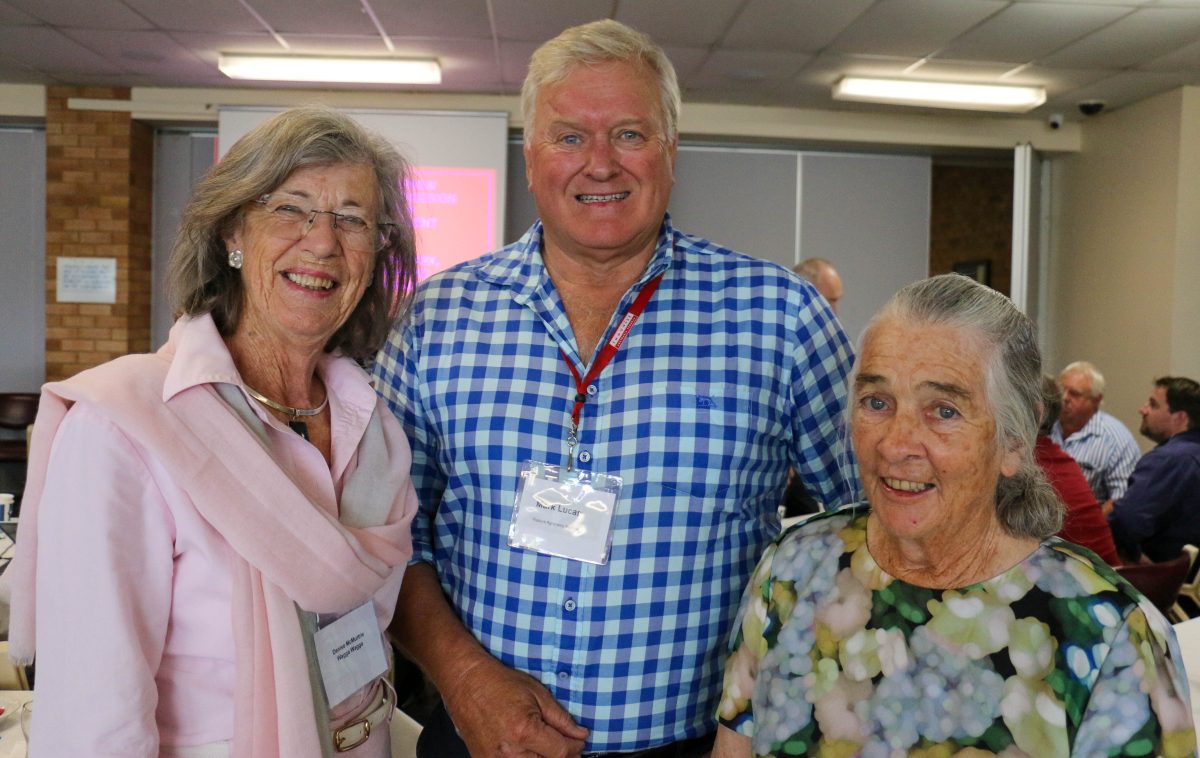
The heavy lifting agriculture does for the nation remains “unrecognised” … Southern NSW agronomist Mark Lucas and Wagga’s Denise McMurtrie and Jan Ovenden. Photo: Supplied,
Denise McMurtrie grew up knowing exactly where her food came from.
“We’d watch the sheep being killed on our farm every week, the cows being milked every day … I grew up with a real understanding of how the insides of the animals worked,” she said.
“That’s not normal for people now.”
That disconnect between where our food is grown and where it’s consumed is one of the critical issues facing Australian agriculture today, the 72-year-old Wagga beef farmer said.
“Until people start to respect how food gets on the table, the good work of Australian farmers won’t be recognised,” she said.
“The fact that we can go to the supermarket and there are 20 varieties of lettuce on the shelves – doesn’t anyone think for a minute who provided the lettuce or the fact you’re paying two dollars and the farmer gets 50 cents?
“It doesn’t matter what job you do – even if you’re a neuroscientist – everyone needs to eat.”
The “heavy lifting” agriculture does for the nation remains unrecognised, southern NSW agronomist Mark Lucas told a recent conference at Gundagai.
“Each Australian farmer produces enough food each year to feed 600 people and are spending an average of 65 hours a week farming,” he told the Pasture Agronomy Service conference in March.
“That heavy lifting … is being done by fewer and fewer farmers. Beef is one of our biggest export earners.”
The average age of farmers had blown out to 63 years compared to the national average age of retirement of 56 years, Mr Lucas said.
“The happy days in agriculture were back in the 1960s when there were plenty of skilled workers but fast forward to 2020 and farmers were working 65 to 70 hours a week despite the adoption of technology.”
The conference heard that although farmers manage 55 per cent of the nation’s land mass, there were just 87,800 farming entities registered in Australia in 2022, down 33 per cent on 1999-2000.
Mr Lucas suggested performance based payments could help stem the tide of farmers exiting the industry.
“We have to harvest more profit from our business rather than thinking higher feeder and lamb carcase weight prices will last forever,” he said.
“Processors and producers need to have respect for each other, show loyalty and develop relationships in an increasingly technical world.
“I would like to think the industry is mature enough to sit down and discuss with farmer groups how producers can be rewarded for the performance of their cattle or sheep if using elite genetics.
“There needs to be a greater degree of objectivity about trying to make more money from the same product as working harder and harder to produce more is a dumb aspect of farming.”
Ms McMurtrie, who attended the conference, said this was the age-old problem for farming.
“We are price-takers and because we have essentially a perishable product – whether that’s fruit and vegetables or needing to sell animals at a certain weight – then we can’t control our market,” she said.
“People in the middle get quite a bit of the profit. You only have to look at JBS and Cargill; they are big companies making a lot of money because they are integrated from go to whoa.”
Ms McMurtrie, who has two sons in farming, runs Angus cattle with her 88-year-old husband Robert Hartwig on their 800-acre Wagga property and several other farms.
Her husband went from trucks into farming as a “second life” when he met Ms McMurtrie and the couple share it now as a “great interest”.
“I used to think when I retired I’d like to go around to schools with an education program about what farmers do, to put our case up that farmers are good people who love the soil – because without it, we don’t have a farm,” she said.
Indeed, Ms McMurtrie believes one of the biggest problems for the country is it’s never faced a famine.
“We’ve never looked like running out of food,” she said.
“People forget how brilliant Australia is at producing good food. This is an amazing country.
“We have got to educate people that paying for food is not expensive – that the type of food they eat contributes to their health and longevity.
“And that’s something worth paying for.”







